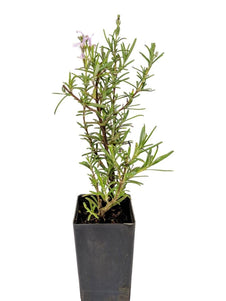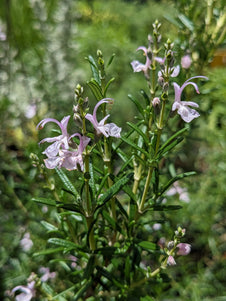





Rosemary - Majorca Pink Rosemary
Rosemary - Majorca Pink Rosemary

- In stock, ready to ship
- Inventory on the way

Usually available: All year
Life cycle: Perennial
Height: 1 - 2m
Position: Full sun
Soil preference: Well drained
This is how we pack and send your Herb Plants to all states except TAS & WA
You will receive
- 1 Majorca Pink Rosemary Herb Plant in a 50 X 75mm tube - General growing instructions
All of our Herb Plants are grown organically with certified organic potting mixes and fertilizers
Botanical Name: Rosmarinus officinalis 'Marjorca Pink'
Rosemary ‘Majorca Pink’ is a tall, loose upright shrub with a spread of 50cm to 2.0 meters high by 50cm to 1.0 meters wide. Its branching habit can create a loose sprawling effect, as the branches twist around the plant and then cascade down at the ends. The foliage is fragrant with the lanceolate leaves being a little shorter than other rosemary’s and tending towards a green –grey colour. The unusual lavender pink flowers are more subdued than those of Rosemary ‘Portugese Pink’ and flowering is quite sparse, although often prolonged. The main flowering period is in spring from August to October, but if conditions are good then flowering may be continuous. When positioned near blue flowered rosemary the flowers provide a nice contrast.
This rosemary is typical of the group and prefers full sun to part shade, well drained soils and tolerates drought, poor soils and coastal conditions. This cultivar is also quite frost tolerant. Rosemary ‘Majorca’ is very similar in habit and appearance to Common Rosemary. It may also go by the common names ‘Majorca’, ‘Roseus’ and ‘Rosens-Cozart’. The original source of Rosemary ‘Majorca’ is said to be a wild form collected from the Balearic Islands in the Spanish Mediterranean.
Rosemary General
Rosemary is an evergreen, woody shrub native to the Mediterranean region of Europe. It belongs to the Lamiaceae or mint family, with the botanical name Rosmarinus officinalis. This name is from the Latin words ‘ros’ meaning dew and ‘marinus’ from the word for sea. Together they refer to the ‘dew of the sea’, because these plants grow in near coastal areas. There are many varieties, distinguished by being upright or prostrate, ranging in size from low ground covers to large shrubs reaching 1.5-2 meters high. The leaves are small and often needle like, ranging from green to grey-green with a pine like aroma produced by the essential oils in the foliage. The small flowers are bee attractants and range from pale pink, purple, white, and include a range of distinctive blues. They usually bloom from early spring to summer, sometimes with a new flush in autumn.
Rosemary is a hardy plant that needs little attention once established. Soil should be well drained and slightly alkaline, the aspect should have full sun or partial shade and plants require occasional watering. Rosemary is tolerant of dry periods, coastal conditions, poor soil, hot and windy aspects and even has moderate frost tolerance. Humid conditions, wet soil or excessive frost will cause problems for the roots and foliage. Plants may be pruned to shape, with larger varieties being suitable for hedging. Propagation from cuttings is easy for most home gardeners.
Most people know rosemary as a culinary herb, especially in Italian cuisine. However, this herb also has a history of medicinal use, including being reputed to improve memory. Of course, many gardeners grow Rosemary ornamentally or just for the lovely fragrance it imparts to the garden.
For more information on history, growth conditions, culinary and medicinal use please see our Common Rosemary listing and other varieties such as Tuscan Blue
All information provided on this website is for informational purposes only. Please seek professional advice before commencing any treatment.





